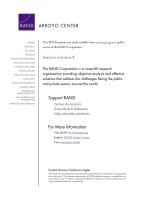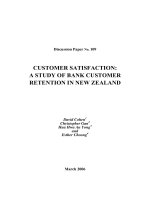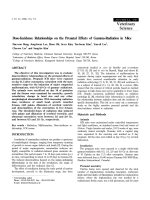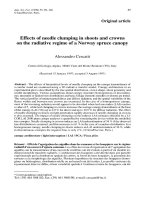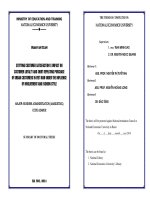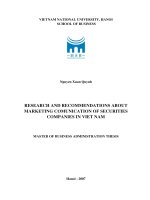The effects of switching barrier on the customer retention a study of ceramic companies in vietnam
Bạn đang xem bản rút gọn của tài liệu. Xem và tải ngay bản đầy đủ của tài liệu tại đây (567.09 KB, 84 trang )
MINISTRY OF EDUCATION AND TRAINING
UNIVERSITY OF ECONOMICS - HOCHIMINH CITY
NGUYỄN THỊ MỸ TRANG
THE EFFECTS OF SWITCHING
BARRIER ON THE CUSTOMER
RETENTION
A STUDY OF CERAMIC COMPANIES IN VIETNAM
MASTER’S THESIS
MASTER IN BUSINESS ADMINISTRATION
Ology Code: 60.34.05
Supervisor
PhD. TRẦN HÀ MINH QUÂN
Ho Chi Minh City -2012
ABSTRACT
Many previous researches proved that retaining customers plays an important role for
business in service sector and end-user or consumers are their oriented-object.
However, there is a lack of research in the areas of evaluation of B2B customer
retention in product sector in Vietnam. Therefore, the purpose of this study is to
determine critical factors of switching barrier that potential influence on customer
retention in business-to-business (B2B) sector in Vietnam ceramic companies. Based
on previous studies on switching barrier, four major factors will be calculated as
move-in cost, benefit/loss cost, interpersonal relationship and the attractiveness of
alternatives. The overall purpose of this research is to develop a conceptual foundation
of customer retention, with the use of the concepts of switching barrier and customer
retention, and provide management significance of customer retention for marketers of
Vietnam ceramic companies in developing strategies for retaining B2B customers.
i
ACKNOWLEGEMENTS
Although I have taken efforts in this research but it would not have been finished
without the kind support and help of people. Therefore, I would like to extend my
sincere thanks to all of them.
First of all, I would like to express my sincere gratitude towards my direct supervisor
PhD. Tran Ha Minh Quan for his great guidance, support and encouragement in
completing the research.
I am very thankful managers of My Duc Ceramics Limited Company for their share
opinions, experiences and providing necessary information regarding to the research.
I would like to express my special gratitude to my family and my friends for the love,
support and encouragement during the whole process of my project which helps me in
starting the first difficult step and completion of my thesis.
Finally, my thanks and appreciations also go to my colleagues in developing the
project and agents of MDC for their kind co-operation in answering the questionnaires.
I also thank to person who willingly helped me out with their abilities.
My heartfelt thanks to you all!
Nguyen Thi My Trang
Ho Chi Minh City, April 2012
ii
STUDENT DECLARATION
I affirm that the research titled ―The effects of switching barrier on the customer
retention – A study of ceramic companies in Vietnam‖ is my own work. The work is
original except where indicated by special reference in the text. The research has been
conducted in studying by the academic knowledge and with the assistant of my
supervisor and MDC‘s managers.
By this letter, I would like to undertake that it is my own research. All data, resources,
references using in this research are clearly identify.
SIGNED: .............................................................
DATE:..........................
iii
TABLE OF CONTENT
ABSTRACT ................................................................................................................. i
ACKNOWLEDGMENTS ........................................................................................... ii
STUDENT DECLARATION ..................................................................................... iii
TABLE OF CONTENT .............................................................................................. iv
LIST OF FIGURES ..................................................................................................... vi
LIST OF TABLES .................................................................................................... ..vii
LIST OF ABBREVIATIONS .................................................................................. .viii
CHAPTER 1:
INTRODUCTION............................................................................ 1
1.1
Rational of the study ................................................................................................... 1
1.2
The statement of the problem ..................................................................................... 1
1.3
Research objective ...................................................................................................... 3
1.4
Research questions ..................................................................................................... 3
1.5
Scope of the research .................................................................................................. 3
1.6
Research methodology ............................................................................................... 4
1.7
The structure of the research ...................................................................................... 4
CHAPTER 2:
LITERATURE REVIEW ............................................................... 6
2.1
Ceramic tile................................................................................................................. 6
2.2
B2B customer ............................................................................................................. 7
2.3
Customer satisfaction ................................................................................................. 9
2.4
The relationship between customer satisfaction and customer retention ................. 10
2.5
Customer‘s retention ................................................................................................ 11
2.5.1.
Define of customer retention ............................................................................ 11
2.5.2.
Benefit of customer retention ........................................................................... 12
2.5.3.
Switching barrier .............................................................................................. 13
2.6
2.5.3.1.
Switching cost .......................................................................................... 17
2.5.3.2.
Attractiveness of alternatives.................................................................... 19
2.5.3.3.
The interpersonal relationship .................................................................. 19
Research model and hypothesis ................................................................................ 20
2.6.1.
Proposal of research model............................................................................... 20
2.6.2.
Initial hypothesis .............................................................................................. 21
CHAPTER 3:
3.1
RESEARCH DESIGN ................................................................... 23
Research design ........................................................................................................ 23
3.1.1.
Research purpose .............................................................................................. 23
3.1.2.
Research approach ............................................................................................ 23
iv
3.1.3.
3.2
Research process............................................................................................... 24
Official research ....................................................................................................... 25
3.2.1.
Measurement scale ........................................................................................... 25
3.2.2.
The questionnaire design .................................................................................. 27
3.2.3.
Research sample and sampling ......................................................................... 28
3.2.4.
Data collection methods ................................................................................... 28
CHAPTER 4:
DATA ANALYSIS AND FINDINGS ........................................... 29
4.1
Characteristics of the samples .................................................................................. 29
4.2
Statistical Result ....................................................................................................... 30
4.2.1.
Variables for measuring switching barrier ....................................................... 30
4.2.2.
Variables for customer retention ...................................................................... 32
4.3
Data Analysis ............................................................................................................ 32
4.3.1.
Reliability evaluation through Cronbach‘s Alpha ............................................ 33
4.3.2.
Evaluation the measurement scale by using Exploratory Factor Analysis ....... 36
4.3.2.1.
Some rules in EFA test ............................................................................. 36
4.3.2.2.
EFA for switching barrier ......................................................................... 37
4.3.2.3.
EFA for customer retention ...................................................................... 40
4.3.3.
The adjusted research model ............................................................................ 42
4.3.4.
Modeling Testing.............................................................................................. 42
4.3.4.1.
Correlation coefficient analysis ................................................................ 42
4.3.4.2.
Regression Analysis ................................................................................. 44
CHAPTER 5:
CONCLUSIONS AND RECOMMENDATIONS ...................... 48
5.1
Conclusions .............................................................................................................. 48
5.2
Recommendations .................................................................................................... 49
5.2.1.
Benefit/loss cost................................................................................................ 49
5.2.2.
Interpersonal relationship ................................................................................. 50
5.2.3.
Move-in cost ..................................................................................................... 51
5.3
Research limitations ................................................................................................. 53
REFERENCES ....................................................................................................................... 54
APPENDIX ............................................................................................................................. 60
APPENDIX 1: Questionnaire ................................................................................................. 60
APPENDIX 2: Cronbach's alpha analysis result and Factor analysis result..................... 64
v
LIST OF FIGURES
Figure 2.1: Kim et al. (2004) ......................................................................................... 17
Figure 3.1: The suggested research model .................................................................... 21
Figure 3.2: Research process ......................................................................................... 24
Figure 4.1: Sample characteristics ................................................................................. 30
Figure 4.2: Research model ........................................................................................... 42
vi
LIST OF TABLES
Table 2.1: Define of switching barrier variables ........................................................... 15
Table 3.1 :Summary of retention factors and measurement scale ................................. 27
Table 4.1: Descriptive statistics of switching barrier measurement .............................. 32
Table 4.2: Descriptive statistics of customer retention measurement .......................... 32
Table 4.3: Reliability test of switching barrier and customer retention ........................ 34
Table 4.4: Final Reliability test of switching barrier and customer retention ............... 36
Table 4.5: Rotated Component Matrixa ......................................................................... 38
Table 4.6: Rotated Component Matrixa ......................................................................... 39
Table 4.7: KMO and Bartlett‘s Test ............................................................................. 40
Table 4.8: Total Variance Explained ............................................................................. 41
Table 4.9: Final EFA analysis result of customer retention .......................................... 41
Table 4.10: Pearson correlation matrix ......................................................................... 43
Table 4.11: Model Summaryb ........................................................................................ 44
Table 4.12: ANOVAb .................................................................................................... 45
Table 4.13: Coefficientsa ............................................................................................... 45
vii
LIST OF ABBREVIATIONS
B2B: Business to Business
B2C: Business to Consumer
DONG TAM: Dong Tam Group
EFA: Exploratory Factor Analysis
MDC: My Duc Ceramics Limited Company
VND: Vietnam Dong
WHITE HORSE: White Horse Ceramics Company
viii
CHAPTER 1: INTRODUCTION
1.1 Rational of the study
Infrastructure construction is one of top interests in Vietnam as well as other
countries in the world. Moreover, with high growing rate of urbanization and
increasing demand for housing of middle class in society pushing up the construction
of public works and high-floor projects by Government and investors. Based on that,
the building material industry in Vietnam get opportunity to develop and ceramic
industry is not an exception with the quite stable growth in the last ten years.
According to Vietnam building ceramic association, the building material market has
grown by 10%/year in the last 2000-2005 period and 20%/year in 2 years after.
Therefore, Vietnam ceramic tile is an attractive market drawing investors in both
domestic and overseas as its potential profits and has had the participation of 20
companies up to now. In order to compete and grow in this competitive markets, each
ceramic company must strongly focus on retaining existing customer, special for
business customers who tend to be fewer in a number and each is more valuable, and
gaining new ones as the more customers company has, the more profits it get.
Business is in a constant race to increase profits. Therefore, ceramic companies
should invest on retaining customers, especial for difficult times. But striving to
maintain unprofitable customers is not a good business strategy. Companies should
identify 20% of potential customers who bring 80% of profits to business. In ceramics
industry, agents are company representatives who create 80% of revenues to
companies. So we need a research to find the critical factors adjusting to their
retaining. Its aims to help organizations build effective customer retention strategy in
a way that both firms and the customer get the most out of exchange, providing both
parties with long term benefits.
1.2 The statement of the problem
Many previous studies have identified the benefits of retention to an organization
(Colgate et al., 2007; Reichheld and Sasser, 1990) but relatively little research on B2B
customer retention. And although many companies have realized the economical
advantage of keeping existing customers against acquiring new ones, almost ceramic
1
companies still focus on developing new customers rather than maintaining old
customers and invest on customer satisfaction more than retaining customers. Their
own decisions base on the traditional information about the profit and customer
satisfaction.
Firstly, organizations except that expanding the market or developing new
customers is the best way maximize profits. However, it is the fact that acquiring new
customers is more expensive than keeping existing customers. According to Reichheld
and Sasser (1990), a 5% improvement in customer retention can cause an increasing in
profitability between 25% and 85% (in terms of net present value) depending upon the
industry. With long term relationship, customers tend to be less inclined to switch, less
price sensitive, less expensive to service and may initiate free word of mouth
promotions and referrals. So that saving cost and getting more profit can be reach by
maintaining customers. It is the reason that many firms focus on customer retention
which is aimed at building strong long term relationships that keep customers coming
back repeatedly.
Secondly, in traditional understanding, customer satisfaction is often seen as the
key to a company‘s success and long-term competitiveness because it could lead
customers to repurchase and keep stay with current providers. Hence, it is often
viewed as a central determinant of marketing by almost firms. But even if customers
have high satisfaction, they could change to other suppliers. Moreover, according to
John Wiley & Sons, Inc (1997), if direct relationship of customer satisfaction,
customer relationship management and customer loyalty is weak or even nonexistent,
switching barrier is a factor affecting to customer‘s decision to stay or not with the
current providers. It plays a role of adjustment variable in the interrelationship
between customer satisfaction and customer retention (Lee & Cunningham, 2001;
Colgate & Lang, 2001; Jones et al, 2000; Kim et al, 2004) (Trung voi doan Literature
review ne). From that, the firms should note that customer retention must be more
invested in the future.
The competition is hard in today‘s ceramic business and the building material
market is quite because of economic crisis. To survive in this environment, firms
should improve their ability to be dynamic and be different from the competition.
2
Customer retention helps organizations to keep the existing customers to continue
purchasing with current providers. And even dissatisfied customers can be retained
through switching barrier which is one of factor effecting on customer retention.
Although company seems to be doing well at the time, but systematically
upgrading the customer retention strategy could further enhance the company‘s
competitive abilities. Therefore, this study emphasizes on factors impact on switching
barriers of agents in ceramic companies in Vietnam. The purpose of this thesis is to
provide a better understanding of customer retention concept in B2B sector to ceramic
industry. And it can offer some ideas to improve company-customer relations and
adjust the presented condition of companies.
1.3 Research objective
The purpose of this research as following:
-
To identify significant factors of switching barrier effect on customer retention
in Ceramic Companies in Vietnam
-
To measure the effect of these key factors related with customer retention in
Vietnam ceramic companies.
1.4 Research questions
-
What are the main determinant factors impacting on B2B customer retention?
-
How can these factors influence on customer retention by the view of agents in
Ceramic Companies in Vietnam?
1.5 Scope of the research
Due to the limited time, the research is conducted to the agents (B2B customers)
of My Duc ceramic company who are also sales representative of Dong Tam Group
(Dong Tam) and White Horse Ceramic Company (White Horse) and other ceramic
companies in Vietnam.
The conclusions will be derived from this research are limited to big companies
such as My Duc Ceramic company, Dong Tam and White Horse and will be based on
the information of this result.
3
1.6 Research methodology
This research is conducted by using qualitative approach through interviewing
experienced experts and quantitative method.
The data collected from the survey was primarily obtained through structured
interview. The questionnaires are delivered to agents of MDC in three main markets in
Vietnam directly.
Qualitative research: This step is researching by in-depth interviews with
manager of My Duc ceramics Company (International Sales Manager, Local Sales
Manager and Service Team Manager) in order to discover and adjust the customer
retention dimensions. The result of this research is used for designing the
questionnaire used for official study.
Quantitative research: this research is researching by delivering questionnaires to
agents of MDC in Hanoi City, Danang City and Ho Chi Minh City directly. SPSS
version 16.0 will be used for analyzing the collected data.
1.7 The structure of the research
This research includes five chapters:
Chapter 1: Introduction
As presented, this chapter mentioned about rational of the research, statement of
the problem, research objectives, research questions, scope and limit of the research
and research methodology.
Chapter 2: Literature review
This chapter gives theories related to customer retention or background for the
research.
Chapter 3: Research Methodology
This chapter develops the research model, hypotheses, research process and a
methodology for data analysis.
Chapter 4: Research finding and result
4
This chapter gives the research finding according to analysis the collected data
Chapter 5: Conclusions and Recommendations
It is the final chapter which summaries the most important findings and provides
recommendations on improving customer retention strategy in Vietnam ceramic
companies. It also presents the suggestion for future research.
5
CHAPTER 2: LITERATURE REVIEW
2.1 Ceramic tile
Historically, ceramic tile has been made since 4000 years for human‘s demand in
creating living spaces which were beautiful, durable, and user friendly. Beautiful tiled
surfaces have been found in the oldest pyramids, the ruins of Babylon, and ancient
ruins of Greek cities. Decorative tile work was invented in the near East, where it has
enjoyed a longer popularity and assumed a greater variety of design than anywhere in
the world. Europe decorated tiles came into general use outside from the second half
of the 12th century. The mosaics of Spain, Italia, and ceramic tile of England,
Netherlands and Germany are all prominent landmarks in the history of ceramic tile.
Nowadays some countries in Asia such as Malaysia, Thailand, Indonesia, Sri Lanka,
China, Indian and Vietnam become producers of ceramic tile.
Ceramic tile - made of clay, sand and other chemical - cut pieces into shape and
be dried beneath the sun or fired in a kiln under high heat to create the finish product.
According to number of firing, ceramic tiles can be divided in to two groups: unglazed
tiles and glazed tiles. Unglazed tile was fired once and glazed tile was fired twice.
Basing on the used purpose, there are two types of ceramic tiles including roofing tiles
used in Mission-style architecture and hand-painted porcelain tiles intended for
ornamentation (decorative tiles). Now the tile has a wide variety of designs, shapes
and sizes, textures and surface effects.
Ceramic tile can be used in a range of application, including walls, floors,
ceilings, fireplaces, in murals, and as an exterior cladding on buildings. Because of
beauty and high durability, ceramics are caused for commercial buildings, particularly
in lobby areas and restrooms.
* Vietnam ceramic companies
The production of ceramics in Vietnam has a long history dating back to ancient
times. It first appeared during the Bac Son period (4th-3rd centuries BCE) and ceramic
production underwent vigorous development during the Lý period (1010-1225). Over
the following centuries, as demand for high-quality pottery and porcelain increased,
many other important ceramic production centers emerged through-out the country.
According to Vietnam ceramic association, ceramic industry was built in 1986. In the
6
first time, it had 3 factories and increase to more than 20 factories until now. Some of
them applied high technology system to meet the demand for higher end product such
as My Duc ceramics, Dong Tam, White Horse, Primer Group, Viglacera, etc. My Duc
ceramics, Dong Tam ceramics and White Horse ceramics herein are some of top brand
of ceramic industry. They are considered as companies that have significant
improvements in products and service. MDC is top brand for high-end customers with
high quality of product and services. Dong Tam is brand for a wide variety of designs
for mass market segment. White Horse got 3rd, after MDC and Dong Tam.
Vietnam has followed similar trends developing countries which Government
attaches exaggerated important to build material and technological foundation.
Vietnam‘s strong capability in terms of design and artistic quality has enabled it to
become a major supply hub of ceramics products. This industry is supported by
several craft villages located in different provinces. With models from the country
blend traditional craftsmanship with contemporary influences, ceramics dominate as
the top product line accounting for more than 60 percent of total output an. Nowadays
Vietnam becomes the largest tile manufacturer in Southwest Asia and ranks among the
largest industry tiles in the world.
The potential of ceramic tiles seems to be great with the high growth over the
last few years. However, the problem of ceramic industry is abundance of goods
because of existence a lot of ceramic companies involving domestic and foreign firms,
special China‘s tiles which almost their products have price cheaper than price of
domestic companies. In addition, economic crisis has strong affect on business of
ceramic industry. Therefore, it needs to be improved.
2.2 B2B customer
B2B customer is contemporary shorthand for a longtime sales practice called
business-to-business. B2B transactions primarily target companies and other wholesale
buyers, while transactions targeting individuals are called B2C, or business-tocustomer. Many organizations have both B2B and B2C components, but it's not
unusual for a company to specialize in B2B services or sales. In fact, the vast majority
of products and services sold are considered to be B2B in nature.
7
B2B customer have different characteristic compared with B2C customer: Products
for B2B are often more complex, B2B buyer are more ―rational‖, personal
relationships are more important in B2B market, B2B buyer are longer-term buyers
and B2B customers have needs-based segments. The behavioral and needs-based
segments that emerge in B2B markets are similar across different industries. Here are
these segments:
A price-focused segment, which has a transactional outlook to doing business
and does not seek any ‗extras‘. Companies are often small.
A quality and brand-focused segment, which wants the best possible product
and is prepared to pay for it. Company aims to high margins, focus on
product/service as of high strategic importance. They are medium-sized or
large.
A service-focused segment, which has high requirements in terms of product
quality and range, but also in terms of after-sales services, delivery, customer
service, etc. They are usually purchasing relatively high volumes.
A partnership-focused segment, usually consisting of key accounts, which
seeks trust and reliability and regards the supplier as a strategic partner. They
require the product and service as strategically important. They tent to be large.
B2B communities tend to be much smaller than B2C communities, the needs of
the members more focused and intense around specific product, service or problemsolving scenarios. In addition, the B2B community can impact on the organization
powerfully, thanks to the direct on core operations such as customer service,
marketing, product development, product groups and sales. Therefore, companies must
provide excellent customer service for all interactions. However, good business-tobusiness customer service is not something that is easy to obtain. Companies should
invest to well skilled training for several employees to handle customer service issues
and problems. An internal training procedure is the way that many companies applied
to help staff handle problems quickly and professionally. And external training is
another way for almost company. Companies could combine two kinds of training or
chose one of them according to their purpose. In summary, business-to-business
customer service requires a customer service department to handle issues or problems
8
in which individual employees can be expert consultant. This can help company to
prevent issues to become major problems can ruin a company‘s reputation. Therefore,
organizations should spend amounts of time to handle customer service tasks and
activities.
The final distinguishing factor of B2B is business-to-business buyers are more
demanding because of their responsibility in making the right decision when
purchasing on behalf of their companies. They need quality to be less risk and paying
more than they would as a consumer and therefore expect more in return. They would
like to interaction with the product or service supplied to them, rather than playing the
role of passive recipient.
Business customers tend to be regarded as long-term customers more than
consumers with more valuable. One major reason for the popularity of B2B sales and
services are sheer volume. Without a B2B component, the manufacturer would have
lost out on a very lucrative sale. Therefore, retaining them are enormous benefits so
the consequences of losing them is very serious.
2.3 Customer satisfaction
Customer satisfaction is an important theoretical as well as practical issue for
most marketers and consumers researches (Dabholkar et al., 1996; Fournier and Mick,
1999; Meuter et al., 2000). It is considered as the essence of success in competitive
market. There are many define of customer satisfaction. Hansemark and Anbinsson
(2004) states that satisfaction is an overall customer attitude towards a service
provider, or an emotional reaction to the different between what customers anticipate
and what they receive, regarding the fulfillment of some need, goal or desire. Zeithaml
and Bitner (2000) defines satisfaction as ―the customer‘s evaluation of a product or
service in term of whether that product or service has met their needs and
expectations‖. Kotler (2000) says that ―satisfaction as a person‘s feelings of pleasure
or disappointment resulting from comparing a product‘s perceived performance (or
outcome) in relation to his or her expectations‖. In summary, customer satisfaction is a
respond to meet or exceed the customer‘s expectation by company‘s performance. It is
clearly a worthy objective for business.
9
2.4 The relationship between customer satisfaction and customer retention
Although there are more than 1,200 articles published in the area of customer
satisfaction (Perkin, 1991; Wilkie, 1990), but in recent times, according to Rush &
Zahorik (1993), satisfaction has
been an potential factor for
the
retention of
customers, and therefore it has moved to the forefront of relational marketing
approaches in large publication. Besides, Kotler (2000) said that the key to customer
retention is customer satisfaction. It is demonstrated that there is the relationship
between customer satisfaction and customer retention. The higher customer is
satisfaction, the more customer loyalty and the less churn. However, competitive
market could modify this relationship. Customers are more easily retained even with
poor levels of customer satisfaction in less competitive markets. And in high
competitive market, because of more expecting and more choices, customers could be
move to other provider even high level of satisfaction (J.Best, 2009). Kordick (1988)
demonstrated that 15% of the unsatisfied customers returned to the same dealers
despite their dissatisfaction. And according to Gierl (1993), between 40% and 62%
of the
interviewed customers stated that they
had changed the brand even
though they were satisfied. Further more, she stated that the rate of retention of
customer dissatisfaction (due to a dissatisfactory state) exceeded that of satisfied
customer in eight of nine examined product classes.
In addition, many marketers accept that retention equals satisfaction in term of
repurchase intention. However, customer satisfaction does not mean that they will
continuous to purchase with current provider because what customers say versus how
they actually behave. When customers are satisfied with product and/or service or
brand name of company, it not means they need to repurchase. Otherwise, if other
companies offer them greater relative value, customers could switch to them. There are
many reasons for spending money for one company while being satisfied with others.
Therefore, in highly competitive market, the link between satisfaction and
retention is only weak or even nonexistent in some of the analysis.
10
2.5 Customer’s retention
2.5.1. Define of customer retention
It is hard to define customer retention because the true meaning of customer
retention is the subject some controversy. Some authors accept retention as
repurchasing, intending repurchase, referral or feeling of loyalty to the brand.
According to Zeithanl et al (1996), the retention refers to repurchase intentions,
positive and negative worth of mouth, and price sensitivity. And Aspinall (2001)
demonstrates that customer retention, customers‘ repetition or renewal to use product,
to response all organization‘s activities based on their satisfaction or any reasons, links
to the way provides maintaining the existing customers based on establishing a good
relationship with all people who buy the company‘s product. In simple way, customer
retention is the activity that a selling organization undertakes in order to reduce
customer defections. Simply, retention means that the customer has not defected or
remains active. In business, to achieve the target, companies seek to get a customer
and keep the customer, avoid the cost to additional expense in case of acquiring and
losing customer. So retention strategies discussed in this thesis focus on activity, or
intent to repurchase, or any other relevant indicators that the customer has not
defected.
In addition, customer retention is not the same as customer loyalty and should
not be held as loyalty (Oyeniyi and Abolaji, 2008) in spice of the fact that loyalty and
retention are considered as the source of profit. Although not conceptually unified
but we can understand loyalty including both attitudinal and behavioral dimensions.
Behavioral conceptualizations are concern of ‗loyalty‘ purely in terms of revealed
behavior such as repeat purchase behavior, proportion of purchases, sequence of
purchases. Attitudinal conceptualizations mentions about ―loyalty‖ as interesting in
brand, feeling committed to it; recommend it to others, and having positive beliefs.
According to Uncles et al. (2003) and Blackwell et al. (1999), attitude toward a brand
is a weak predictor of repurchasing because repeat buying is moderated by contingent
factors: individual‘s characteristics, circumstances, and purchase situation. Customer
retention does clearly not contain any attitudinal aspects (Jacoby & Chestnut, 1978)
and a customer may be retained but not necessarily loyal to the product or service of
11
the providers. For retention, customer‘s mandatory or voluntaries are the reason for
their retaining with the current provider. Moreover, loyalty is higher level of retention
in customer behavior and attitude. With feeling of loyalty, customer is not move to
new suppliers who offer attractive benefits.
Successful customer retention starts with the first contact of an organization
with a customer and continues throughout the entire lifetime of a relationship.
Customer retention is exceeding customer‘s expectations in order to build customer‘s
loyalty. In which companies puts customer value rather than maximizing profits and
shareholder value at the center of business strategy.
To improve customer retention rate, let‘s think about value added service which
can provide benefits for company and customer in long term. It helps companies keep
the old customers over their competitor with good feeling from customer. In other
word, it helps customers‘ business to see organization as a partner than supplier
because partners are as interested in making the business succeed as the owners are so
organization must concentrate on the uniqueness of your customers.
* Repurchase intentions
According to Hellier et al.(2003), ‗repurchase intention‘ is proposed model to
be a customer‘s judgment about again buying a designated service from the same
service provider, taking into account the customer‘s current situation and likely
circumstances. Purchase intentions can incorporate psychological influences,
economic and environmental considerations, and the customer‘s ability and need to
make a purchase (Pickering and Isherwood, 1974).
2.5.2. Benefit of customer retention
As mentioned above, customer retention has a direct impact on profitability.
First, the revenue from long-term customers can be increased more than 1.7 times
compared with revenue from the normal customers (John Fleming and Jim Asplund,
2007). Second, the cost of creating a new customer has been estimated to be give times
higher than the cost of retaining an existing one (Reichheld and Kenny, 1990; Koler,
2000; Rust and Zahorik, 1993) and the higher a business‘s customer retention rate is,
the greater the profit impact is (Best, 2009). And the long-term relationship takes
lower cost than beginning of a relationship (John Fleming and Jim Asplund) because
12
long term customers tend to be less inclined to switch and also tend to be fewer prices
sensitive. They may initiate free word of mouth promotions and referrals and tend to
be satisfied with their relationship with the company and are less likely to switch to
competitors, making market entry or competitors' market share gains difficult. They
also more likely purchase ancillary products and high-margin supplemental products.
Therefore, profits can be increased by customer retention efforts (Buchanan and
Gilles, 1990). In other words, customer retention is the source of conversion to
customer profitability because of its attractive performance.
Furthermore, when company increases customer retention, it makes the
employees' jobs easier and more satisfying. In turn, happy employees feed back into
higher customer satisfaction in a virtuous circle. So that companies should give good
reasons to keep customer in the long term.
2.5.3. Switching barrier
The influence of switching barrier to customer retention in business is getting
the attention of researchers. Among many previous researches on customer retention,
some models focus on customer satisfaction considered as the main factor influenced
the retention (Fornell, 1992) but even a satisfied customer is lured away by
competitor‘s offer or other attractive alternatives (Jones and Sasser, 1995). Vice versa,
for some cases, according to Reichheld (1996), some unsatisfied customers may
choose not to defect, because they do not except receive a better delivery elsewhere.
Therefore, satisfaction is not always an assurance of customer retention, special for
high competitive market. From that, the concept of the switching barrier was proposed
and researchers also set their focus on customer retention with the influence of
switching barrier except satisfaction. They found that a switching barrier also is a
factor which affects to a customer‘s decision to stay or not with the current provider.
Further, they note that the switching barrier plays the role of an adjustment variable in
the interrelationship between customer satisfaction and customer retention (Lee &
Cunningham, 2001; Colgate & Lang, 2001; Jones et al., 2000). Kim et al. (2004)
demonstrates this issue by evaluating the effect of customer satisfaction and switching
barrier on customer retention in her thesis.
13
As mentioned above, in high competitive market, even high satisfaction,
customer can change to other provider because of many choices and the satisfaction
can‘t explain fully about customer loyalty or repurchase behavior. The model for
customer retention mentioned the switching barrier factor is studied by many
researchers in various areas. Almost researchers argue that switching barrier can be
seen as positive or negative to customer retention due to its factor. Switching barrier is
considered as the most important thing effecting on customer retention because it
related to the social and emotional cost which the customer will perceive when
changing to a new provider (Fornell, 1992) and it makes it difficult or costly for
customers to change providers (Jones et al, 2000). Dwyer et al. (1987), Heide and
Weiss (1995) said that customers are motivated to stay in existing relationships to
economic on the types of switching cost. These potential costs thus constitute a
significant barrier to moving to other service providers when customers are dissatisfied
with the services of a provider. Empirical support for the influence of switching costs
on retailer–supplier loyalty has been provided by Ping (1993).
Many authors researched and defined the switching barrier variables following:
Author
Year
Typology
Tore Nilssen
1985
Endogenous cost: attractiveness of alternatives
Exogenous cost: switching cost
Rusbult et al
1986
Alternative quality: how appealing are the alternatives
Investment in relation: time, energy, self-disclosures,
shared experiences, a number of children, etc…
Guiltinan
Turnball
Wilson
1989
and
Uncertainty cost: cost associated with the psychological
uncertainty that accompanies the performance of an untested
service provider
Set-up cost: the time and effort associated with the process
of initiating a relationship with a new provider, or setting up
a new service for initial use
14
Benefit/loss cost: Contractual arrangements often mean that
there are economic benefits in staying with an incumbent
firm, and the potential loss of these benefits thus represents a
disincentive to switching
Wilson et al.
1995
Hard assets: equipment
Liu
2006
Soft assets: procedural investments and customer-specific
expertise which enhance switching cost perceptions
Paul Klemperer
1987
Switching cost: transaction, learning and artificial
1995
Fornell
1992
Search costs, transaction costs, learning costs, loyal customer
discounts, customer habit, emotional costs, cognitive effort,
financial, social and psychological risk
Ping
1993
Switching cost: cost in the time and money to change
supplier
Attractiveness of alternatives: how much better or worse in
various dimensions an alternative wholesaler would be
Investment: how much time, energy and money invested in
the relationship
Uniqueness of investment in this wholesaler
Jones et al
2000
Interpersonal relationship: friend or bond with employee
Switching cost: hassle to change, time and effort
Attractiveness of alternatives: how good other suppliers
would be in comparison with current supplier
Table 2.1: Define of switching barrier variables
Switching barrier is made by many factors due to the definition of researcher.
According to Fornell (1992) and Jone et al. (2000), the switching barrier refers to
difficulty or costly of moving to new carriers, brands or products that is occurred with
15
customer who is dissatisfied with the current providers. Fornell (1992) provides a list
of factors that can constitute such barriers: search costs, transaction costs, learning
costs, loyal customer discounts, customer habit, emotional cost, cognitive effort and
financial, social and psychological risk. It relates to the financial, social or
psychological burden felt by this customer. Tore Nilssen (1992) stated that
endogenous costs and exogenous costs are the factor of switching barrier. If
Endogenous costs or switching cost mentions about internal cost/effort to retain
customers, exogenous costs (attractiveness of alternatives) play the role as barrier
pushing by the competitors.
Compared with the large number of studies that have investigated switching
barriers in consumer markets, relatively few studies have investigated this subject in
B2B markets, in which almost researches have studied the effects of: (i) Switching
cost (Lam et al., 2004; Nielson, 1996; Sengupta et al., 1997; Wathne et al., 2001); (ii)
Interpersonal relationship (Young and Denize, 1995); (iii) Attractiveness of
alternatives providers (Ping, 1993, 1997, 2003). In 2004, with the purpose of testing
the role of switching barrier in the context of loyalty in Korean mobile
telecommunication service, Kim et al. also examined the model with the same factors
of switching barrier such as Switching cost, Interpersonal relationship and
Attractiveness of alternatives. In Vietnam market, Ho Thi Phuong Minh (2009) uses
the similar model to evaluate the effects of switching barrier on customer retention in
mobile service. Therefore, three types of switching barrier such as Switching cost,
Interpersonal relationship and Attractiveness of alternatives are considered in the
research.
16

